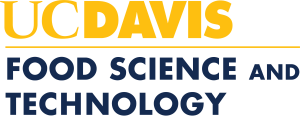This brief overview of the department's first fifty years appears in The Centennial Record of the University of California, 1868-1968, compiled and edited by Verne A. Stadtman and the centennial publications staff (Berkeley, University of California Print. Dept., 1967).
Food Science and Technology: The present department can trace its origin to the Volstead Act in 1918. That year, the Department of Viticulture and Enology (on the Berkeley campus), founded by Eugene W. Hilgard and chaired by Frederic T. Bioletti, promptly terminated most of its activities related to wine making and substituted the term "fruit products" for "enology" in the departmental title. William V. Cruess had presented a lecture course as early as 1915 on canning, drying, fruit juices, and non-alcoholic beverages. After 1918, he was assigned to the fruit utilization program and named Arthur W. Christie to handle the area of sun-drying and dehydration and John H. Irish to the area of fruit juices, concentrates, and non-alcoholic beverages. By 1924, Cruess and Christie had collaborated on a technological book Commercial Fruit and Vegetable Products. The department was then housed in Hilgard Hall, with offices, laboratories, and a small pilot plant.
During 1918-26, the shipment of early fresh California fruit was geared to the demands of the eastern market, a system which created potentially valuable wastes (culls). Primary research emphasis was given to the problem of utilizing such farm wastes by processing, rather than to the development of food processing methods. During 1926-30, Cruess and M. A. Joslyn proposed freezing storage to preserve fruits and vegetables for consumer use and a laboratory course was added stressing that method of food preservation. In this same period, Christie was succeeded by Paul F. Nichols and Emil M. Mrak, Maynard A. Joslyn, George L. Marsh, Byron J. Lesley, Harold S. Reed, and Gilbert A. Pitman were added to the non-academic staff.
During the five years following the repeal of Prohibition in 1933, courses were expanded to include biochemistry and microbiology as well as fermentation. The present chairman (1967), R. H. Vaughn, joined the staff in 1936 to teach microbiology. Upon Bioletti's retirement in 1938, the Division of Viticulture and Fruit Products was split into the Division of Fruit Products, with Cruess as chairman at Berkeley, and the Division of Viticulture and Enology, with Albert J. Winkler as chairman at Davis. The former became the Division of Food Technology in 1944. In 1949, the year after Mrak became chairman, dairy industry and viticulture and enology became associated majors by Academic Senate approval of a food science curriculum developed by joint action of the three groups. This same year, a graduate program leading to the M.S. degree was begun.
In 1951, instruction began in a new building (now known as Cruess Hall, following dedication ceremonies in March, 1960) for food technology at Davis. Professors Mrak, Marsh, Vaughn, Herman J. Phaff, and Clarence Sterling were the first academic staff members. They were later joined by Clinton O. Chichester, Alloys L. Tappel, Richard A. Bernhard, John R. Whitaker, Martin W. Miller, and George K. York.
In 1959, the division became the Department of Food Science and Technology. Chairman Mrak was named chancellor at Davis and the dairy industry and the food science and technology staffs were consolidated under the chairmanship of George F. Stewart, who was succeeded in 1963 by Vaughn.
The consolidation of the dairy industry and food technology groups added seven staff members: Edwin B. Collins, Walter L. Dunkley, Eugene L. Jack, Nikita P. Tarassuk, Walter G. Jennings, Thomas A. Nickerson, and Lloyd M. Smith. Recent additions include Robert E. Feeney, Michael J. Lewis, Mendel Mazelis, and Morris H. Woskow. Three emeriti professors complete the present staff complement: Cruess, Chester L. Roadhouse, and Jack.
-- George L. Marsh
